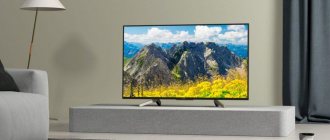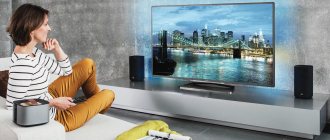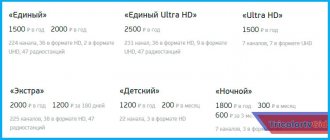Throughout the year, television equipment manufacturers produce a huge number of models that differ in functionality, technical characteristics, service life and, of course, price segment.
It's no surprise that choosing a TV is an extremely difficult job for a professional, let alone the average consumer. It is very easy to get confused in the varied assortment. To make your life easier, we have prepared the TOP 10 models from leading manufacturers.
The creation of the 2021 TV rating was carried out in accordance with the recommendations of experts. Therefore, the likelihood of purchasing low-quality TV equipment is completely excluded. After analyzing a huge amount of information, we have determined which TVs are now the best. Therefore, you can choose an option with the optimal combination of price/quality without any problems.
Size matters
If you already have a flat panel TV, then you know what to do. That's right, get the next model with a bigger screen! Because no matter how cool and top-end the 32″ TV you bought a few years ago was, by today’s standards it’s already very little - most impressions will pass you by.
Based on your budget, we advise you to look at models at least in the 40-42″ segment: there are the majority of these on the market, and the price is not particularly high - you can find adequate offers from leading brands for about 25,000 rubles and more. For example, Samsung UE43N5000AU and many similar models.
If money and free space in the room allow, feel free to take 50-55″, this is, as a rule, the “golden mean” in price for each inch. Models such as the LG 50UK6300 will cost you about 40,000 rubles, but the difference in cost will quickly make up for the impression due to its size. In addition, it is in this price category that the newfangled 4K (Ultra HD) comes across, about which a little later.
If you don’t want money, and just yesterday you returned from the Cote d’Azur, then there is no shame in choosing TVs in the 65″ and larger segment. You should have already understood this without our advice. Let's save you time: see LG OLED65B8.
Are the indicated sizes scary? This is the norm! In fact, the optimal distance for a large 55-inch Full HD TV is about 2.2 meters. In the case of 4K TVs, you can sit much closer, so watching such screens from 1.5 meters is absolutely normal: this way you can better experience all the detail in the picture.
Daewoo U43V895VTE
If you want to enjoy images in ultra high resolution, then the Daewoo U43V895VTE for 22,000 rubles ($330) will allow you to do this. The TV has a screen diagonal of 43 inches and a resolution of 3840 x 2160 pixels. It features an IPS matrix with wide viewing angles and excellent color rendition.
Today's popular smart TV functions are also present here and run on Android TV. There is also a powerful surround sound of 8 + 8 watts and a number of proprietary Daewoo technologies that improve the image. For example, the MGDI Plus Engine function, which improves color reproduction, reduces digital noise and corrects distortion.
About the benefits and harms of 4K
The 4K format has gradually ceased to be exotic and has penetrated even into the middle segment. Today you have a great chance of buying a 4K TV if your budget reaches 50,000 rubles. However, is it worth pursuing this so much?
The fact is that if you watch mainly terrestrial or digital television (cable, satellite, IPTV), then the local signal, which has a maximum of 1080 lines, will be scaled exactly 4 times to the “native” resolution of the TV. Losses cannot be avoided, and the picture will seem more “soapy” than in the original. That is, you will not be able to feel any special advantages, and in this case it is enough to choose a TV with Full HD resolution.
If you plan to actively watch movies and TV series, play on modern consoles or a powerful PC, then buying a 4K TV becomes completely justified. Moreover, pay attention to HDR support - you will need it at a much higher resolution. With so much content now being shot in 4K and being polished for release in 4K HDR, the shortage has been left behind.
Select screen shape: flat vs curved
The curved screen is another not very successful marketing ploy. Although the image quality has improved, comfortable viewing angles have suffered greatly - to view, you need the same distance to all points of the TV screen. Visit the store and look at it a little from the side - you will understand everything yourself. This will provide you with some inconvenience when watching with family or friends. Therefore, a flat screen TV would be a better choice.
HDR is what you need
Manufacturers quickly realized that people were in no hurry to jump at 4K. Yes, there are many more pixels on the screen, but what actually changed from this? Obviously, it is necessary to improve the dynamic range (brightness, black depth) and color in order to produce a real wow effect and make the picture more vibrant.
All this became possible with the advent of the High Dynamic Range (HDR) format. It is based on the idea of conveying as much as possible of the original visual information captured by a professional camera. Previously, footage had to be heavily compressed to fit into the outdated video standard for the home market: 8-bit color depth, Rec. 709. As a result, the gradient “stratified” on beautiful sunsets, and it was impossible to convey the true bright red color of the Ferrari on the screen.
Modern 4K HDR TVs offer a completely different picture: smooth 10-bit gradation, increased brightness and contrast range, and a wide Rec. 2020/DCI-P3 - like in digital cinemas. If you have the appropriate content in HDR, the difference with the regular HDTV format becomes quite noticeable: the image is as high-quality and realistic as today's technology allows. The increase in the range of brightness and color depth is visible to the naked eye even to an inexperienced viewer, although here too much depends on the content.
The HDR format has become quite widespread in games: today, almost all significant releases on PlayStation 4 and Xbox One come out with HDR10 support. However, in the case of Xbox, you will need more recent modifications - One S or One X. Perhaps the best demonstration of gaming in HDR should be called Gran Turismo Sport, since this game was originally honed for this format, right down to capturing the sources. On a PC with HDR, things are a little more complicated (as usual), but the point remains the same: the TV still needs this feature to remain relevant for years to come.
Despite the bright prospects, there are also pitfalls here: not all HDR TVs are created equal. The fact is that many mid-level models can only receive a 4K HDR signal, but then display it in a reduced form, since their 8-bit panel is not very bright. You can tell a “good” 4K HDR TV from a “bad” one by having an Ultra HD Premium certificate, which indicates compliance with the required parameters, although it is not a guarantee of better quality. Also pay attention to the support for Dolby Vision - an improved HDR video format, which is found in some releases and is superior in picture quality to the common HDR10.
Before purchasing, don’t be lazy to look for information: watch videos, read reviews of the selected model to find out how it performs in HDR and what formats it supports. Remember that HDR is an important and useful feature that will future-proof your TV. If you decide to buy a 4K TV, then you shouldn’t skimp on HDR to avoid disappointment.
Additional selection options
Sound
Since modern TVs are thin, the speakers installed in them are small. They cannot provide high-quality low and high frequencies, and not everything is smooth with the mids.
Do you want high-quality sound? Buy a separate multi-channel sound system with a subbuffer. To do this, you need to make sure that there is a digital audio transmission channel. It's also a good idea to have a standard 3.5mm jack - this is the cheapest way to get more or less high-quality sound using high-quality headphones. And a headphone jack will never be superfluous.
Color gamut
The technologies for producing matrices have been rolled out a long time ago, so they have a fairly high-quality picture, covering a wide color range. For aesthetes, there are precise manual settings. In general, if you are not involved in graphic design, then there is no point in paying special attention to this parameter.
Just in case, you can launch a bright dynamic video. If the colors of a person’s skin, grass, sky, look quite natural, then everything will be fine with other colors too.
LED vs. QLED vs. Is OLED even legal?
While OLED technology—a true next-gen—was reaching the mass market, competitors had already managed to creatively tailor the marketing names of their products to this cherished combination of letters. But we will teach you to understand all this.
LED technology
LED TVs, also known as LED LCD TVs, are the most common type today. They are based on a regular LCD panel (most often VA or IPS), equipped with a backlight made of light-emitting diodes (LEDs), which is where they get their name.
This technology is inexpensive to produce, covers all possible screen sizes and has an acceptable image for most viewers. Therefore, it has become the most popular, although largely due to the “cheap and cheerful” segment, where there are simply no alternatives to it.
Where to find? Everywhere! Every company has such TVs.
QLED technology
A logical evolution was QLED TVs and their derivatives, which are structurally very similar to LED LCD (LCD matrix + backlight unit), but a new element was added to the panel - a layer of quantum dots (Quantum Dots). It was they who gave the letter “Q” to the name.
Quantum dots significantly expand the reproduced spectrum, so the colors on such TVs are deeper and more saturated, just right for the HDR format. Their brightness reserves are also increased, and the top models with carpet-backlit screens also have improved black depth.
Otherwise, their characteristics are similar to LED LCDs: the same limitations on viewing angles, the same response times, the same backlight unevenness across different copies, so the most noticeable difference between LED LCDs and QLEDs appears in the HDR format. It’s not for nothing that we said that it is important!
Current model: Samsung QE55Q7F.
Where to find? Generally speaking, the main manufacturer of QLED TVs is Samsung, but such models are in the Hisense and TLC catalog. Similar analogues with quantum dots are also produced by LG, Sony and Philips.
OLED technology
In turn, OLED TVs represent an alternative technology, where each pixel is an independent light source and does not require a separate backlight, unlike the above-mentioned LED LCD or QLED technologies. Hence the lowest panel thickness - about 4 mm.
Due to the complexity and high cost of production, OLED still occupies only the upper segment, but such TVs provide the most vibrant and high-quality picture, regardless of the type of signal. In addition, OLED screens can be combined with a flexible substrate, which allows you to create unique models like a “rollable” TV.
OLED has the highest contrast, free viewing angles, and fast response time. Experts agree that OLED is currently the “Holy Grail” of picture quality, so when choosing a top-end TV, it’s logical to start your search here. Moreover, the price of OLED TVs is often lower than QLED, oddly enough. And you certainly shouldn’t confuse these two technologies: as you can see, they are not the same thing at all.
Current model: LG OLED55B8.
Where to find? The only manufacturer of OLED panels at the moment is LG, but OLED TVs from other brands are also produced on their basis: Sony, Panasonic, Philips. Premium brands Bang & Olufsen, Loewe and Metz have also launched their OLED TV lines in the top segment.
MicroLED technology
MicroLED TVs are a category that is already looming on the horizon, but has not yet reached the masses. In essence, this is the same as OLED TVs, only the LEDs in them are inorganic. In theory, this makes them more stable, durable and potentially cheaper. Although at the moment there is no talk of mass production: modular MicroLED TVs with huge 146″ screens are being prepared for release. It is possible that someday this technology will be able to compete with OLED.
AOC LE43M3570
First in our ranking in alphabetical order is the Hong Kong company AOC, which is well known to Russian users for its TVs and monitors. This model, for its 20,000 rubles ($300), has a special feature - a high-quality IPS matrix, which allows you to view video with high detail, good brightness and has wide viewing angles.
The model is perfect for pairing with a game console and boasts powerful built-in acoustics of 8 + 8 watts. The 43-inch diagonal screen displays images at a maximum resolution of 1920 x 1080 pixels. Users appreciated the capabilities of the TV and noted that the AOC LE43M3570 is also suitable for connecting to a personal computer as a monitor.
What happened to 3D?
In short, it drowned. Consumer interest turned out to be too low, so the 3D format practically left the home market, remaining in cinemas. It’s not hard to guess that many factors led to this: the need to wear special 3D glasses, a darkened or degraded picture (even with the best technologies), and most importantly, mediocre film releases that were hastily converted to 3D. All this completely undermined interest in this feature.
Current model: LG OLED55C6. If you have a collection of 3D films that you want to watch again, and it’s time to update your TV, then you’ll have to look for the remains of the 2016-2017 models. Among the latest TVs with 3D support are the LG OLED55C6 and Sony KD-55XD9305, although most manufacturers have already completely abandoned this function, there is no other way to say it.
Current model: Sony KD-55XD9305.
Harper 40F660T
Quite an interesting TV manufacturer from Taiwan, which is gaining increasing popularity in Russia due to its low cost and good build quality along with good functionality. The model will appeal to users who are looking for a small 40-inch IPS panel with a resolution of 1920 x 1080 pixels, but equipped with all modern functions.
First of all, this is a smart TV based on the Android operating system. And secondly, excellent sound with a total power of 20 watts. There are all modern connections and support for all video, audio and photo formats. Definitely, this is one of the best TVs in our rating, which will cost 16,000 rubles ($240).
Smart TVs are pretty stupid
You hear so often about smart technology and the Internet of things that it’s hard to resist making jokes. Smart TVs in the modern sense are 10 years old, so what have they managed to learn?
In principle, nothing new: it is still based on simple applications that run on top of the TV shell. Most often these are online cinemas and entertainment services that have already become familiar on the Internet. Obviously, launching a Yandex widget on a TV is not much different from a smartphone. Although in some exceptions, such as Netflix, it is on TVs that additional “goodies” appear: for example, 4K streaming with HDR, which will appeal to owners of cooler models.
The most useful features of Smart TV:
- Online cinemas;
- Transferring content from a smartphone (Google Cast, screen mirroring, etc.);
- Play content from a home media server (DLNA).
With these features, you can always watch the latest series in maximum quality, show friends photos from your smartphone or a YouTube video on the big screen, or watch your collection of films from your home network on TV. Unfortunately, they haven’t come up with anything more interesting yet - that’s where the “smartness” of smart TVs ends.
Among the popular systems, we will highlight proven options: webOS (LG), Tizen (Samsung) and Android TV (Sony, Philips). They are quite usable and functional, but the exotic second-tier manufacturers from China are unlikely to delight you: a clumsy menu, a meager application catalog and inconvenient controls - at every turn.
Mystery MTV-5031LTA2
Our TOP opens with an inexpensive 50-inch TV without unnecessary bells and whistles of the liquid crystal type, which combines a simple design, as well as a large list of interesting functions and capabilities. Thanks to the beautiful thin body, narrow frames around the display, and a sophisticated stand, it can easily be made an integral part of the interior. It is also possible to mount this model on a wall. However, design is not the main advantage of this device.
- stereo support
- Edge LED – backlight
- 1920 by 1080 (Full HD) – resolution
- good processor with 4 cores
- built-in digital tuner
A large LCD TV display can certainly be suitable for a living room as it displays images of the highest quality. The picture looks detailed, clear, bright and rich. LED backlighting significantly increases brightness. Full HD resolution makes viewing as comfortable and enjoyable as possible. You can forget about eye fatigue. The Smart TV function in a budget LED TV opens up a wide range of possibilities for users. This includes Internet access, a variety of applications, and a large amount of high-quality content.
What interesting things await us in the future
In the next couple of years we will see the arrival of 8K as a continuation of Ultra HD. Naturally, the biggest profit from it will be huge TVs with a diagonal of 65 inches and larger. The rest don't have to worry: 4K is enough for the eyes.
The new HDMI 2.1 standard looks much more interesting: it will learn not only to pass 8K, but also support features that reduce lag and artifacts for games. This can be really useful, so we advise you to pay close attention to the version of HDMI ports on your TV in the future. The first models with HDMI 2.1 will most likely appear in 2021.
Display technologies have relatively slowed down in development: there is nothing more progressive than OLED yet, we are waiting for the emergence of MicroLED (inorganic light-emitting diode panels) as a potentially strong competitor. However, they will most likely not reach the mass market soon. But this is a topic for separate stories.
Sony KDL-32WD752
This TV will be a great choice. It combines all the necessary functions of a media center. The screen diagonal is 32 inches - 81 cm. Full HD resolution will give you a high-quality, detailed picture. The surface of the display is glossy, but nothing will reflect, as there is an anti-glare coating. There are two speakers - each with a power of 10 W, the sound is clear, and thanks to Clear Phase technology it seems more realistic.
- 1920 by 1080 – resolution
- X-Reality PRO noise reduction technology
- image refresh rate 400 Hz
- 178° viewing angle
- ability to connect removable drives up to 2TB
Among the numerous interface elements, it is necessary to highlight the presence of Ethernet, SCART, 2 HDMI ports and 2 USB. Among the most interesting technologies in this model you can find: X-Reality PRO, Screen mirroring, as well as 24p True Cinema. You will also be pleased with the design of this high-quality TV, which is perfect for the bedroom. The product comes in a stylish silver color with an attractive stand.











